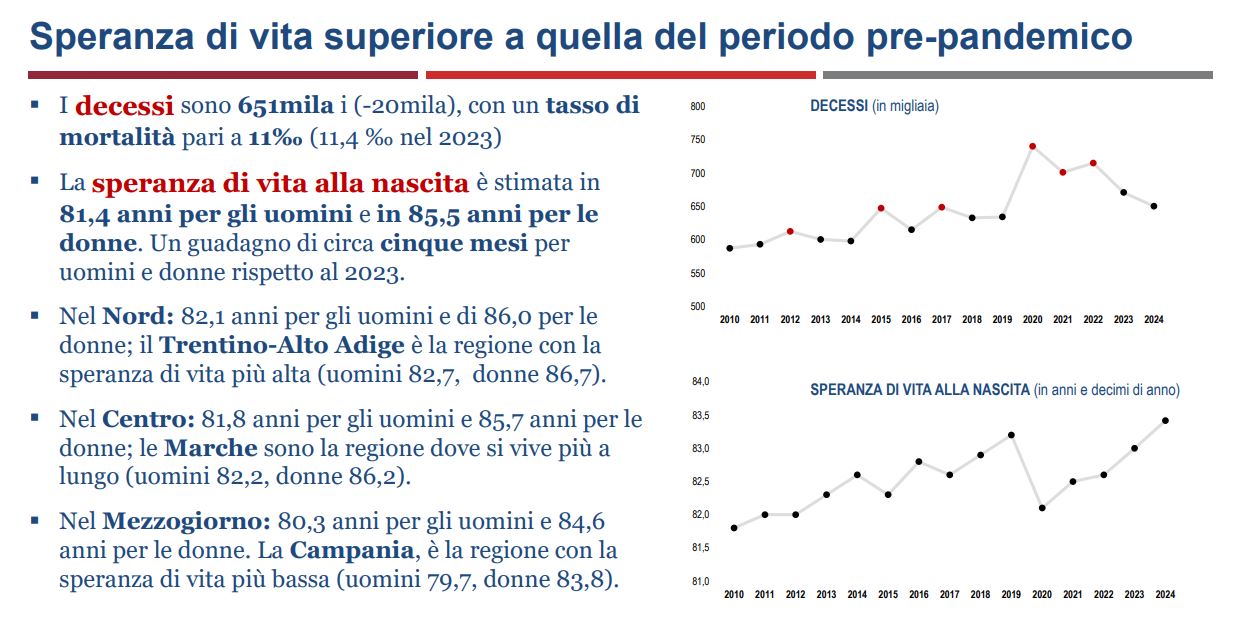Istat, life expectancy rises: in 2027 we will retire three months later, that’s why

Historical minimum fertility: with 1.18 children per woman in 2024, the minimum of 1.19 in 1995 is exceeded. Instead, the Italian neo-cittadini are increasing: 217 thousand citizens granted are granted
Babies decrease and the average life of Italians stretches. According to the Demographic Indicators of Istat published On Monday 31 March, the fertility rate reached the historical minimum: with 1.18 children per woman in 2024, the minimum of 1.19 in 1995 is exceeded.
Instead, the « life expectancy » grows: for the complex of the resident population, life expectancy at birth is equal to 83.4 years, almost five months of life more than 2023.
Life expectancy and the effect on pensions
The effects of growth of life expectancy, the demographic indicator that quantifies the number of years that a person can expect to livewill be quite relevant on pensions.
In 2027 the retirement age and contributions necessary to achieve early retirement They will increase by three months reaching 67 years and three months for old age and 43 years old and one month for the anticipated.
According to data published today by Istat Life expectancy at 65 The highest figure since 2019 has risen in 2024 to 21.2 years. If you look at the comparison between the two-year period 2023-2024 and 2021/2022, a comparison on which the adaptation is based in 2027 of age, it was there that there has been a seven months increase. From these the four months of reduced reduction must be removed, the pandemics last due to the increase in mortality in the oldest range of the population.
With 1.18 children per woman in 2024 the minimum of 1995 is exceeded
Further drop in fruitfulness in Italy. With 1.18 children per woman in 2024, the minimum of 1.19 in 1995 was exceeded, the year in which 526 thousand children were born against 370 thousand in 2024 (-2.6% compared to 2023). This is what emerges from Demographic Indicators of Istat published Monday 31 March. The deaths (651 thousand) also drop, 3.1% less on 2023, given more in line with the pre-pandemic levels than with those of the three-year period 2020-22. The natural balance, or the difference between births and deaths, is therefore still strongly negative (-281 thousand).
Italian citizens
Italian neo-cittadini increase: 217 thousand acquisitions of Italian citizenship granted foreign citizens residing in Italy, exceeded the previous maximum of 214 thousand reached in 2023. As of January 1, 2025 The resident population of foreign citizenship is made up of 5 million and 422 thousand units, Increased by 169 thousand individuals (+3.2%) on the previous year, with an incidence on the total population of 9.2%. 58.3% of foreigners, equal to 3 million 159 thousand individuals, resides in the north, with an incidence of the total of the population residing in the north equal to 11.5%. Equally attractive for foreigners is the center, where one million 322 thousand individuals (24.4% of the total) reside with an incidence of 11.3%. The presence of foreign residents in the South, 941 thousand units (17.3%) is more contained, where they represent just 4.8% of the total resident population.
Life expectancy grows: +5 months
Relevant growth of life expectancy in Italy which in 2024 is equal to 83.4 years, almost 5 months of life more than 2023. This is what emerges from the demographic indicators of Istat released today. At 31 December 2024 the resident population has 58 million 934 thousand individuals (temporary data), down 37 thousand units compared to the same date of the previous year. The decrease of the population continues continuously since 2014 and the decrease recorded in 2024 (-0.6 per thousand) is in line with what is observed in previous years (-0.4 per thousand of 2023 and -0.6 per thousand in 2022).
The different areas of the country
The decline in population does not involve all areas of the country in a generalized way. While in the north the population increases by 1.6 per thousand, the center and the South record negative variations respectively equal to -0.6 per thousand and -3.8 per thousand. In the internal areas of the country it is observed A more intense population loss than the centers. At the regional level, the population is increasing especially in Trentino-Alto Adige (+3.1 per thousand), in Emilia-Romagna (+3.1 per thousand) and in Lombardy (+2.3 per thousand). The regions in which the major losses are found are Basilicata (-6.3 per thousand) and Sardinia (-5.8 per thousand).









